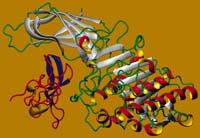They discover a new way of transporting proteins in vegetable cells

A team of researchers from the Consejo Superior de Investigaciones Científicas (CSIC) has found a new way to transport proteins from the reticulum to chloroplasts in plant cells.
Chloroplast is a cell organelle with large capacity for protein collection, but it is not capable of producing glycosylated proteins. Proteins are glycosylated in the reticulum and some of these glycosylated proteins have a high antigen power and pharmaceutical interest.
The starting point of this research was an unexpected discovery. In fact, the team of researchers was then dedicated to investigating the metabolism of starch, which occurs in chloroplasts, and found a type of unexpected proteins in the orgacle.
This protein suffered high temperatures and extreme conditions. These are the characteristics of glycosylated proteins. After verifying that these proteins are present in chloroplasts, the scientists wondered if the organelles themselves glicosila. Thus they knew that there is another means of transport between the reticulum and the chloroplast. They already knew that endoplasmic reticulum is associated with other parts of the cell such as the Golgi apparatus, plasma membrane, etc., but they did not believe it is associated with chloroplasts.





